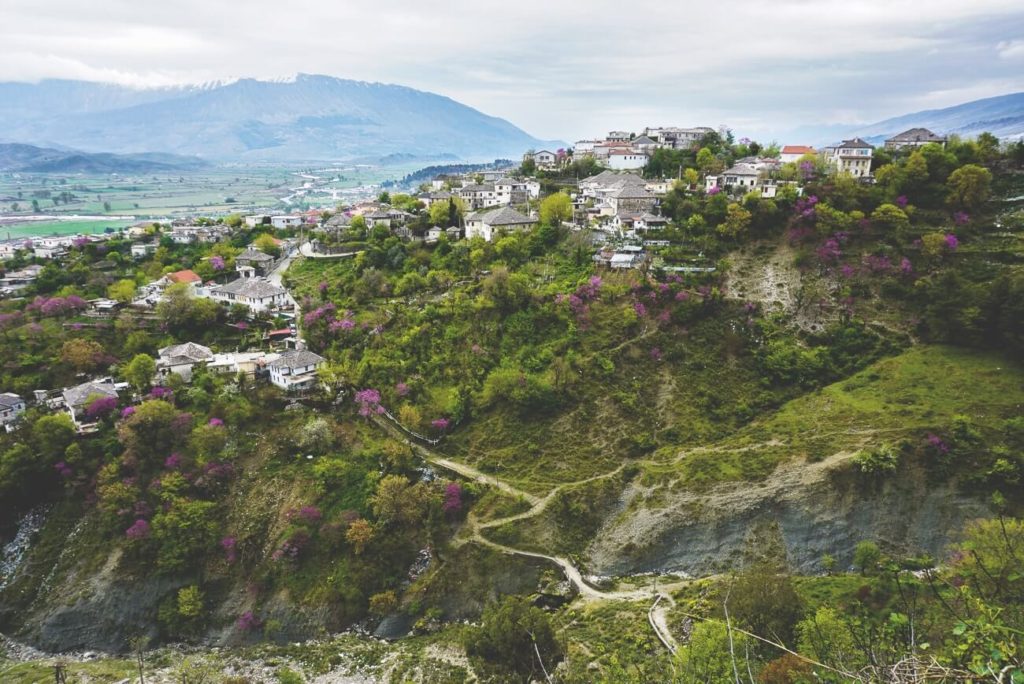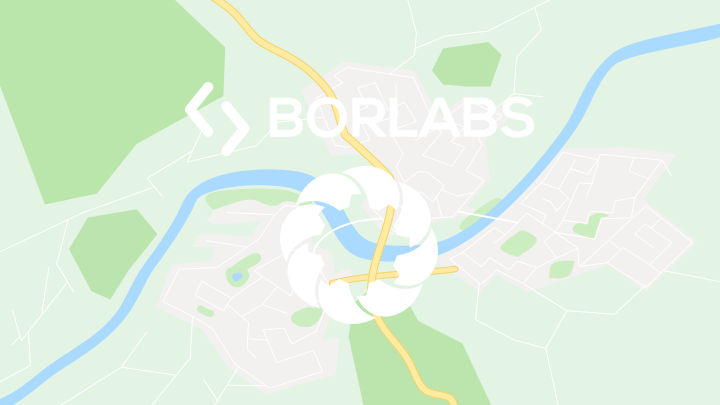We’ve already reported quite a bit about our Albania tour, but the mountainous city of Gjirokastra has received far too little attention so far. Today, however, we want to change that and take you on a city tour through one of the oldest cities in the country. This historic city lies in the broad Drino River valley and is surrounded by the Mali i Gjerë Mountains, with peaks up to 2,000 meters high.
The houses here were built into the steep slopes, so be prepared for lots of stairs and steps. But can you imagine the beautiful views that await you in Gjirokastra? At first glance, this city may seem inconspicuous, but you’ll be quite surprised, especially in the historic old town or on the hill with the fortress. So, let’s go and explore the city on your own!
- About Gjirokastra in Albania
- Getting to Gjirokastra
- Hotels in Gjirokastra
- Sights in Gjirokastra
- Conclusion about Gjirokastra in Albania
About Gjirokastra in Albania
Gjirokastra has been a UNESCO World Heritage Site since 2005 and remains one of Albania’s most important cultural centers. First mentioned in 1336, the city was initially part of the Byzantine Empire before being later conquered by the Ottomans.
During World War II, Gjirokastra fell under various occupations – first by Italy, then by Greece, and finally by Germany. After the war, the Socialist People’s Republic of Albania was proclaimed under Enver Hoxha, who was born in Gjirokastra, and the city became an integral part of Albania.

Today, around 20,000 people live in the city, but emigration has continued unabated since the 1990s. Albania continues to struggle with problems such as corruption, poverty, and unemployment. It’s no wonder that more than 4 million Albanians live abroad, while only about 2.9 million people live in the country itself. Although the economic situation has improved somewhat since the end of the communist regime, the Albanian economy is still one of the least developed in Europe.
Getting to Gjirokastra
If you start from Tirana, it takes about 3.5 hours to get to Gjirokastra via Durrës, Kavajë, Fier, and Tepelenë. If you want to take the bus (€8 from Tirana), you should allow up to 5 hours; you’ll be more mobile with your own rental car*.
We started in the south of the country in Ksamil and made a stop at the famous Blue Eye before continuing on the SH4 to Gjirokastra. The entire 69-kilometer route from Ksamil takes about 2 hours. The problem is that you’re often only allowed to drive very slowly, meaning you can’t get from point A to point B very quickly. So be prepared for long car journeys.

Hotels in Gjirokastra
You don’t just want to take a day trip to this city, but would like to stay a little longer? No problem, there are quite a few hotels and guesthouses in Gjirokastra. We’ve picked out a few for you that have very good reviews, are in a great location, and we also liked the look of them. In Gjirokastra, you can get a room starting at just €12 per night, and the overnight prices are generally very low. We usually book our accommodations at Booking.com*.
- Trigona Hostel*
- Grandpa’s Home*
- Kore Guest House*
- Stone City Hostel*
- Castle Hotel*
- Hotel Gjirokastra*
- Fantasy Hotel*
- Hotel Kodra*
Sights in Gjirokastra
The city of many steps only has a few sights to offer, but they are definitely worth a visit. We’ve marked the most important spots on the map below to give you a better idea of where things are.

By loading the map, you accept Google’s privacy policy.
Learn more
Load map
The Historic Old Town
The paths to the old town lead steeply uphill – even the streets are a bit of a challenge. Once at the top, you’ll find winding cobblestone streets that sometimes wind uphill, sometimes downhill, straight ahead, or around corners. You should also be prepared for numerous stairs and steps – it’s not for nothing that Gjirokastra is called the “City of a Thousand Steps”. In the charming old town, you’ll find many traditional Albanian houses in the typical Balkan architectural style. The flat stone roofs and the narrow, tall windows are characteristic.
Recommendations:
- Rumors Coffee & Snacks
- Kafe Pasticeria Zani
- Restaurant Muço
- Mapo Restaurant

In Gjirokastra you can expect numerous colorful souvenir shops, cozy taverns and restaurants, the historic Gjirokastra Bazaar, the impressive Zekate House (an Ottoman building), a museum for costumes and cultural goods, the Skenduli House, the birthplace of the Albanian writer Ismail Kadare and the Bazaar Mosque. The best way to explore the city is on foot, letting yourself be carried away by the winding alleys.
We started our tour with a short break at the Mapo Restaurant – coffee and warm soup provided the necessary refreshment. A quick note: During our visit in April 2019, the old town was a construction site, either because streets were being repaired or pipes were being laid.

The Castle of Gjirokastra in Albania
Perched high on a hill, the Castle of Gjirokastra offers not only fantastic views of the city but also fascinating insights into its history. The impressive fortress is about 500 meters long and up to 90 meters wide. Inside, there is a long corridor where you can discover weapons and cannons from various centuries. You can find out more about it in the adjoining Weapons Museum.
Outside, a small plane awaits, which, according to legend, was an American spy plane. There is also the former prison, a festival stage, a bastion, a clock tower, and a narrow garden to explore.
- Entrance fee: 200 Lekë (approx. €2) | Museum must be paid for separately
- Opening hours: April – September 9 a.m. – 7 p.m. | October – March 9 a.m. – 5 p.m.
- Address: Rruga Elvia Celebi, Gjirokastra
- Private tour of Gjirokastra from just €20 | Book here*


The Aqueduct of Gjirokastra in Albania
In 1820, the Ottoman ruler Ali Pasha had a 10-kilometer-long aqueduct built to supply the castle with water. Unfortunately, it was almost completely destroyed in 1932, but some remains are still preserved and can be visited. On Google Maps, you’ll find this historical landmark under the name Ali Pasha Bridge.
Cold War Tunnel
The Cold War Museum in Gjirokastra is located in an underground bunker built as an emergency shelter during Albania’s late communist era (1944–1990). The bunker symbolizes the paranoia of dictator Enver Hoxha, who, fearing foreign attacks, had around 750,000 bunkers built—only 150,000 to 250,000 were actually completed.
The bunker in Gjirokastra is about 800 meters long, has 59 rooms, and has been preserved in its original condition. It was designed to serve various purposes even in the event of a nuclear attack, including sleeping quarters, water storage, power generators, and rooms for government and interrogators. Some original furniture is still preserved, but the majority was stolen in 1990.
- Admission: 200 Lekë (1.63 €) | Tunnel tour lasts 20 minutes
- Opening hours: April to October 9 a.m. – 6 p.m. | November to March 8 a.m. – 2 p.m.
- Address: Main entrance near the city administration building
Conclusion on Gjirokastra in Albania
Is a trip to Gjirokastra worth it? We think so! The mountain town is particularly captivating with its winding old town and the fortress, which towers high above the city’s rooftops. The panoramic views from the castle are truly worth seeing and, especially in good weather, a highlight of Gjirokastra, Albania.
We also found the cozy atmosphere in the alleys among the locals very pleasant. It should be noted that we were there off-season (April 2019), so there were hardly any tourists around.
Travel reading tip: Albania travel guide from Michael Müller Verlag with 492 pages. Order here*.